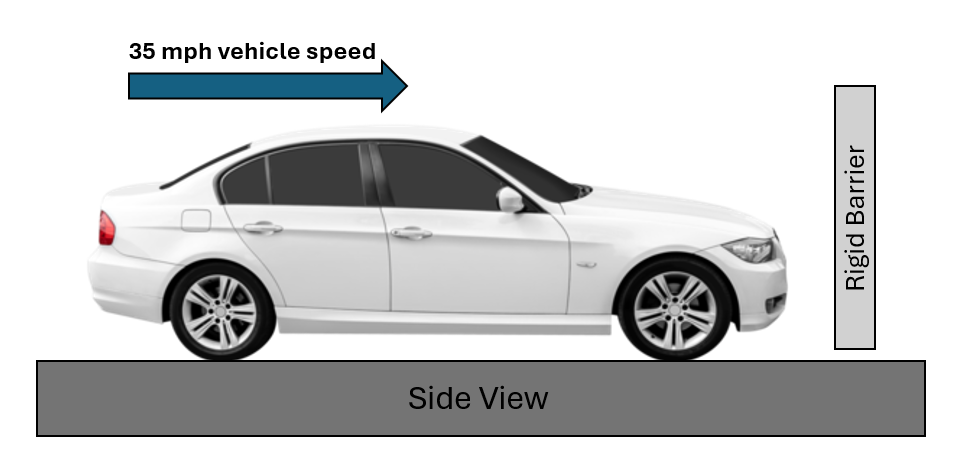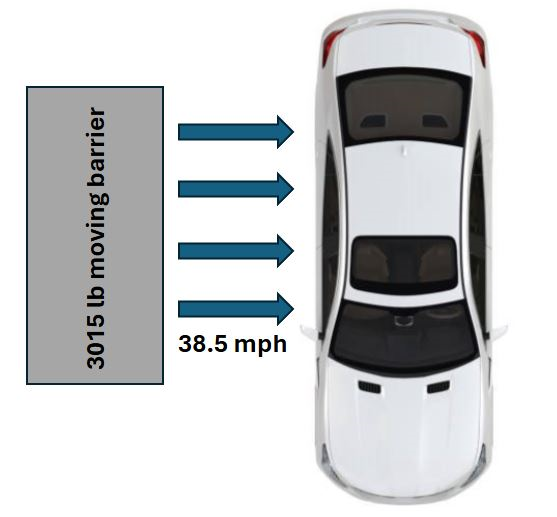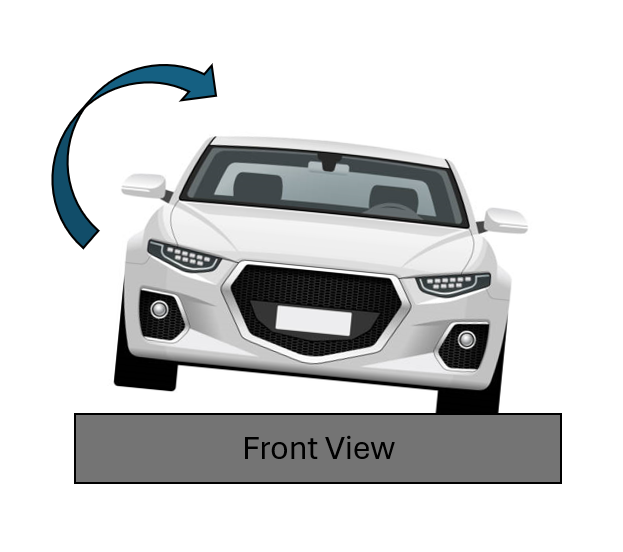NCAP 5 Star Safety Rating
Overview
The 5 Star Safety Rating Program, developed by the National Highway Traffic Safety Administration under the New Car Assessment Program (NCAP), provides users with a simple measure of a vehicle's crash safety performance. The star rating reflects the likelihood of serious injury to the driver and front-seat passenger in various crash scenarios, including frontal impact, side barrier impact, side pole impact, and a rollover. Vehicles are rated from 1 to 5 stars, with 5 stars indicating the highest level of safety (see Star Rating Table). [1]
Impact Crash Test types
 |  |
|---|---|
| Figure 1: Frontal Impact | Figure 2: Moving Side Barrier Impact |
 |  |
|---|---|
| Figure 3: Side Pole Impact | Figure 4: Rollover Impact |
- Frontal Impact (Figure 1)
- The vehicle is crashed into a fixed rigid barrier at 35 mph (Figure 1)
- Moving Side Barrier (Figure 2)
- A stationary vehicle is impacted by a 3,015 lb barrier moving at 38.5 mph
- Side Pole (Figure 3)
- The vehicle is angled at 75 degrees and pulled sideways at 20 mph into a 25 cm diameter pole at the driver’s seating location
- Rollover (Figure 4)
- The vehicle is driven through a sudden steering maneuver at increasing speeds to determine if it tips up or rolls over during the maneuver
Required Inputs
Note: For the NCAP button to activate, all required signals for at least one of the crash tests listed below must be available. If all signals for all four crash tests (frontal, side, moving barrier, and rollover) are available, the calculation for a full rating will be performed.
- Frontal Crash Test:
-
Driver: HYBRID III M50 in Left Front Seat
- Acceleration at the HEAD CG (X - LOCAL, Y - LOCAL, and Z - LOCAL)
- Force at the NECK - UPPER (X - LOCAL, Z - LOCAL)
- Bending Moment at the NECK - UPPER (Y - LOCAL)
- Displacement at the CHEST (X - LOCAL)
- Forces from FEMUR - RIGHT and FEMUR - LEFT (Z - LOCAL)
-
Passenger: HYBRID III F05 in Right Front Seat
- Acceleration at the HEAD CG (X - LOCAL, Y - LOCAL, and Z - LOCAL)
- Force at the NECK - UPPER (X - LOCAL, Z - LOCAL)
- Bending Moment at the NECK - UPPER (Y - LOCAL)
- Displacement at the CHEST (X - LOCAL)
- Forces from FEMUR - RIGHT and FEMUR - LEFT (Z - LOCAL)
- Side Moving Barrier Crash Test:
-
Driver: EUROSID 2 M50 in Left Front Seat
- Acceleration at the HEAD CG (X - LOCAL, Y - LOCAL, and Z - LOCAL)
- Displacement at the RIB - LEFT UPPER, RIB - LEFT MIDDLE, and RIB - LEFT LOWER (Y - LOCAL)
- Force at the EUROSID FRONT ABDOMEN LOAD CELL, EUROSID MIDDLE ABDOMEN LOAD CELL, and EUROSID REAR ABDOMEN LOAD CELL (Y - LOCAL)
- Force measured at the PELVIS PUBIC SYMPHYSIS (Y - LOCAL)
-
Passenger: SID-IIs F05 in Left Rear Seat
- Acceleration at the HEAD CG (X - LOCAL, Y - LOCAL, and Z - LOCAL)
- Force at the PELVIS ACETABULUM LEFT (Y - LOCAL)
- Force at the PELVIS - ILIAC (Y - LOCAL)
- Side Pole Crash Test
- Driver: SID-IIs F05 in Left Front Seat
- Acceleration at the HEAD CG (X - LOCAL, Y - LOCAL, and Z - LOCAL)
- Force at the PELVIS ACETABULUM LEFT (Y - LOCAL)
- Force at the PELVIS - ILIAC (Y - LOCAL)
- Rollover Crash Test
- SSF: Static Stability Factor - provided as user input
- Tip Status: TIP or NO TIP - provided as a user input
Calculation
Frontal Impact
- The X, Y, and Z head acceleration signals for both the driver and passenger are standardized to units of gravity and seconds
- Filters the standardized head acceleration signals with CFC 1000
- Calculates the resultant head acceleration from the filtered and standardized head acceleration signals
- Calculates HIC15 for both the driver and passenger using the resultant head acceleration from Step 3
- Filters the chest compression signal with CFC 600 for both the driver and passenger
- Calculates the maximum chest displacement from the filtered chest compression for both the driver and passenger
- Calculates the peak force at the left and right femur for both the driver and passenger
- Calculates Nij for both the driver and passenger using axial forces, shear forces, and bending moments measured at the neck
- Calculates the maximum tension and compression forces applied to the neck for both the driver and passenger
- The following injury metrics are converted to an injury probability using injury risk curves: HIC15, chest compression, femur force, Nij, neck tension, and neck compression
- The joint injury probability (Equation 1a and 1b) is calculated using all the individual injury probabilities calculated in previous step
- This equation represents the probability of at least one serious injury occurring
Where represent the individual injury probabilities from the calculated injury metrics.
- Calculates the relative risk score (Equations 2a and 2b) using the joint injury probability calculated in previous step
- Calculates a star rating for both the driver and passenger using their respective relative risk scores (see Star Rating Table below)
- Calculates an overall frontal crash star rating
- Calculates the average joint injury probability of the driver and passenger,
- Calculates the overall relative risk using the average joint injury value
- Calculates an overall star rating from the overall relative risk
Moving Side Barrier
- Calculates HIC36 for both the driver and passenger using the resultant head acceleration from Step 3
- Calculates the maximum rib deflection for both the driver and passenger
- Calculates the maximum force at the abdomen for both the driver and passenger
- Calculates the maximum force at the pubic symphysis for both the driver and passenger
- The following injury metrics are converted to an injury probability using injury risk curves: HIC36, rib deflection, abdomen force, and maximum pubic symphysis force
- Calculates the joint injury probability score (Equations 1a and 1b) and relative risk score (Equations 2a and 2b)
- Calculates a star rating for both the driver and passenger using their respective relative risk scores
- Calculates an overall side moving barrier crash star rating
- Calculates the average joint injury probability of the driver and passenger,
- Calculates the overall relative risk using the average joint injury value
- Calculates an overall star rating from the overall relative risk
Side Pole
- Calculates the maximum force at the pelvis for both the driver and passenger using forces measured at the acetabulum and iliac
- The following injury metrics are converted to injury probabilities using injury risk curves: HIC36, pelvis force
- Calculates the joint injury probability score (Equations 1a and 1b) and relative risk score (Equations 2a and 2b)
- Calculates a star rating for both the driver and passenger using their respective relative risk scores
- Calculates an overall side pole crash star rating
- Calculates the average joint injury probability of the driver and passenger,
- Calculates the overall relative risk using the average joint injury value
- Calculates an overall star rating from the overall relative risk
Combined Side Impact Rating
- Calculates the weighted average of the driver’s side pole and MDB risk scores, this is used as the front seat relative risk score
- The passenger’s MDB risk score is used as the rear seat relative risk score
- Calculates the combined relative risk by taking the average of the front and rear seat risk scores
- Calculates a star rating using the combined relative risk calculated in the previous step
Rollover
- Calculates injury probability using the static stability factor and tip status specified by the user
- Calculates the relative risk score (Equation 2a and 2b) and star rating
Vehicle Safety Score
Note: Only calculated if data for all four crash tests are available
- Calculates the weighted average of the relative risk scores from the front, side, and rollover crash tests
- Calculates star rating from the weighted average relative risk score
Star Rating Table
| RRS/VSS | Star rating |
|---|---|
| < 0.67 | 5 (best) |
| 0.67 - 0.99 | 4 |
| 1.00 - 1.32 | 3 |
| 1.33 - 2.66 | 2 |
| >= 2.67 | 1 (worst) |
Star Rating Table (Rollover Only)
| RRS | Star rating |
|---|---|
| < 0.67 | 5 (best) |
| 0.67 - 1.32 | 4 |
| 1.33 - 2.00 | 3 |
| 2.01 - 2.66 | 2 |
| >= 2.67 | 1 (worst) |
References
[1] National Highway Traffic Safety Administration. "Vehicle Ratings." https://www.nhtsa.gov/ratings.